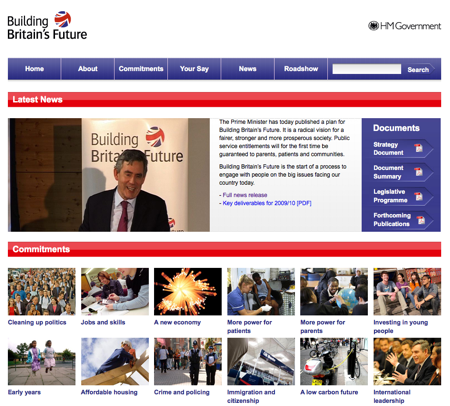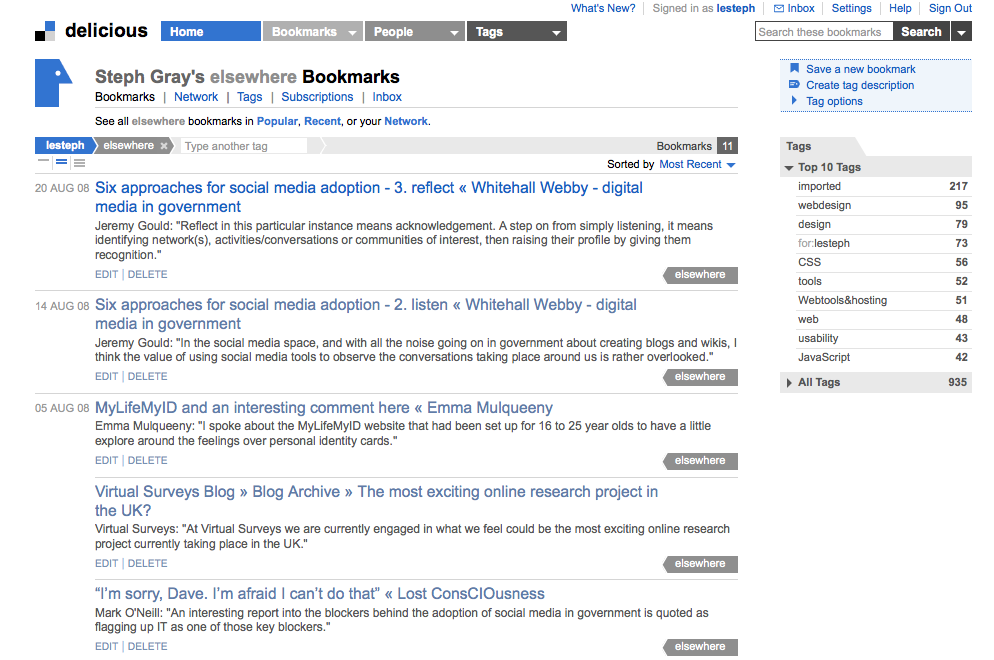Today saw the publication of ‘Building Britain’s Future‘, a wide-ranging document covering the Government’s approach to economic recovery and much else besides.
Rather lower profile was the supporting website, which is a fair crack at how we might present big policy documents online. To me, this is one of the big challenges in digital engagement right now: we have a fair number of tool options for consultations, and are getting better at applying the ‘classic’ social media tools of Twitter, YouTube and Flickr – but the practicalities and small-p politics of presenting large documents in anything more than a downloadable PDF are still daunting. Like Digital Britain or New Opportunities, BBF is not (primarily) a consultation, so has to struggle with the thorny question of what to do with feedback and whether to solicit it at all.

There’s lots to like about the BBF site, ably put together – I believe – by the Cabinet Office web team. The design is clean and fresh, it breaks the introductory text down into bite-size chunks and illustrates the content with a lot of fresh video content and case studies with comments enabled. There’s a Twitter account, a live stream of the PM’s launch speech, a blog and a Google-maps powered overview of the follow-up ministerial roadshows. It looks like it’s hosted on the Cabinet Office Umbraco CMS installation and the blogs use the BlogEngine.NET platform used by DirDigEng – both open source tools which show .NET can be low-cost and agile too. Interestingly, the team didn’t try and publish the whole document in HTML, which I think was a good call. If you want the delivery roadmap, you’ll download the PDF.

Comments
>not very much pick up yet online in the blogs,
>tweeters and forums which might have something
>to say about housing, democratic renewal, low
>carbon and so on.
An outreach campaign to them clearly would have been one of the easiest and most cost effective ways of getting the word out to an audience who would likely be interested in engaging about the issues in the document. Frustrating…
I know what you’re saying Robin, and I agree to an extent. I think people know ‘build it and they will come’ is a fallacy, but the drive is still for the shiny website, not necessarily the traffic (though COI’s new policy on that might change things a little).
But the problem is whose job it is to do this outreach? It’s not the poor old web team who built the thing until silly o’clock in the morning, I’m sure. It’s not really the press officer who’s setting up ministerial media round. It’s probably not the strategic comms manager who’s been project managing the work, who’s chasing proofs and content and event organisers and press notices. Who does this stuff?
I think there are two bits of the jigsaw missing generally from this kind of launch: community management to help sensitively share the policy within the communities interested in its content; and a better platform or set of platforms to really engage people with policy itself, which still presents a polished product Ministers can present, but gets people exploring, challenging, sharing, and writing stuff around the margins.
Clearly there is always the option to outsource this to an external agency… 😉
More seriously, perhaps there’s room for a cross departmental approach to this sort of thing run through the COI or the Director of Digital Engagement?
The work we’ve done so far in this area would suggest that this is an approach that has merit. Quite often it’s the same communities and online influencers that it would be useful for different departments (and policy teams) to talk to, so it would make sense for the indentification of and relationship building with them be handled centrally in order to share the costs and ensure consistancy.
As I hope you can tell, we’ve been thinking about this quite a lot!
🙂
[…] Building Britain